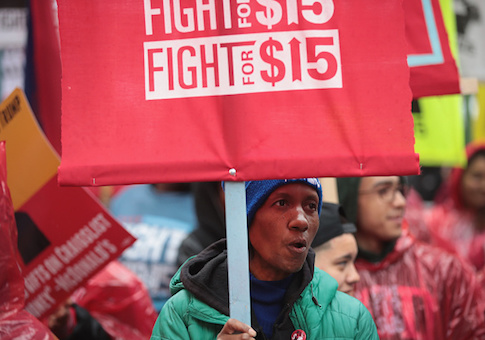The Fight for 15 movement garnered headlines nationwide with demonstrations calling for a $15 minimum wage, but those protests appeared to have petered out in 2017, just four years after its launch, according to a report.
The movement, which has received tens of millions of dollars from the politically influential Service Employees International Union (SEIU), staged protests in just 30 cities in 2017, down from more than 600 in 2016, according to an analysis from the Employment Policies Institute (EPI), a pro-market think tank that opposes minimum wage hikes.
Critics say that the decrease points to the lack of enthusiasm among actual employees at the fast food franchises where protesters amassed, as well as the astroturf nature of the campaign. EPI managing director Michael Saltsman said that the movement is "running out of steam" and contrasted the SEIU's investment in the movement to that of the United Food and Commercial Workers union (UFCW) decision to spin off its effort to unionize Walmart in 2015.
"It appears the SEIU is downsizing its destructive effort, perhaps acknowledging the same lack of interest in its product that caused UFCW to defund 'Our Walmart' a few years back," Saltsman said.
Neither the SEIU, nor Berlin Rosen, which collected millions of dollars of fees from the union to direct public relations for the movement, responded to requests for comment about the budget for the movement in 2017.
The Fight for 15 had been one of Big Labor's most celebrated success stories, spurring California, New York, Washington, D.C., and Seattle, among other locales, to adopt a $15 minimum hourly wage, more than double the federal rate of $7.25. The Democratic Party Platform endorsed the $15 rate in 2016, despite the past objections of nominee Hillary Clinton, who supported a $12 rate to avoid job losses. It also prompted a number of successful ballot initiatives in Republican and Democratic states that raised the minimum wage beyond the federally required rate.
The SEIU spent $60 million on politics, as well as $19 million on the Fight for 15 movement, in 2016, which accounted for 20 percent of the funds collected from its members, according to its most recent federal labor filing. Despite heavy investment in the movement, the union has failed to make inroads into unionizing the 7.88 million workers in the franchise industry.
Matthew Haller, spokesman for the International Franchise Association, said that the sharp decrease in public protests demonstrates that the movement was more dedicated to unionizing workers in the fast food industry than changing minimum wage policies. He called the movement "virtually worthless" to actual employees.
"When you try to sell something that people aren't buying, you tend to go out of business pretty quickly. That's the problem the Fight for $15 is having," Haller said. "[SEIU has] spent $80 million developing a product that's virtually worthless to entry level workers, particularly with a now improving labor market, where employers are competing for the best employees and wages are going up."
Steep minimum wage hikes have hurt some workers, according to academics who study the issue.
Researchers at the University of Washington found in June that the $13 minimum wage rate adopted in 2016 in keeping with legislation that promised a $15 rate cost entry-level and low-skilled workers job opportunities and decreased their monthly earnings by more than $100. Those findings led Mayor Ed Murray's office and Berlin Rosen, the union PR firm, to coordinate with a Berkeley academic to publish a study that downplayed the negative effects of minimum wage hikes.
Mike Whatley, vice president of state and local affairs at the National Restaurant Association, said states and cities have rushed to adopt the $15 minimum wage without considering the economic consequences of the policy. Now the Fight for 15 movement is encountering resistance from those same political leaders after seeing the results.
"Leaders on both sides of the aisle are beginning to see the harmful effects of drastic minimum wage increases without a full economic analysis of their impact on community businesses," Whatley said in a statement. "Seattle is just the most recent example of the negative impact of these dramatic increases. We need policies that help small businesses, like restaurants, create more jobs and opportunities."
Saltsman said that those studies, as well as the empirical data linking minimum wage hikes to job losses have led lawmakers, even in Democratic cities, to desert the movement.
"The labor market harm caused by the movement's signature policy has been documented by headline-grabbing stories and empirical studies," he said. "Even left-of-center locales like Cleveland and Baltimore have rejected labor's unprecedented new wage mandate, recognizing the job-killing consequences of the policy."
